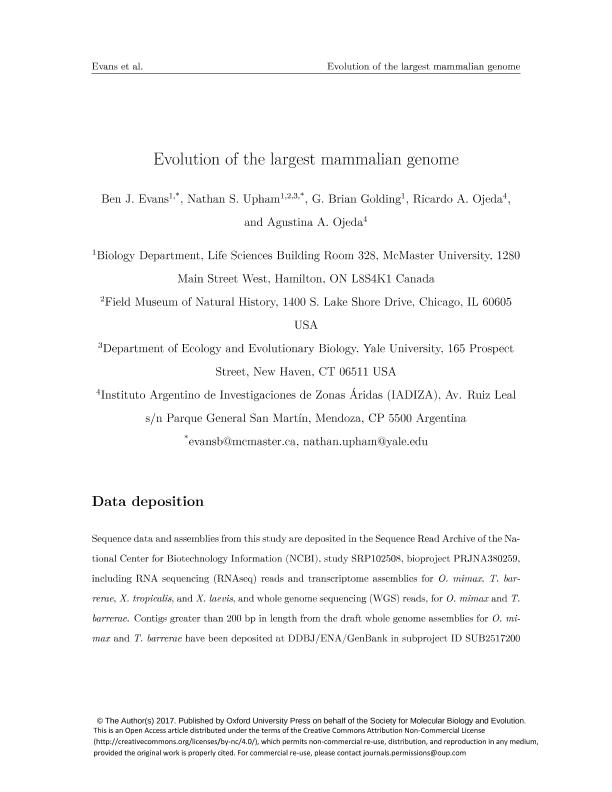Mostrar el registro sencillo del ítem
dc.contributor.author
Evans, Ben J.
dc.contributor.author
Upham, Nathan S.
dc.contributor.author
Golding, G. Brian
dc.contributor.author
Ojeda, Ricardo Alberto

dc.contributor.author
Ojeda, Agustina Alejandra

dc.date.available
2018-04-26T20:13:15Z
dc.date.issued
2017-06
dc.identifier.citation
Evans, Ben J.; Upham, Nathan S.; Golding, G. Brian; Ojeda, Ricardo Alberto; Ojeda, Agustina Alejandra; Evolution of the largest mammalian genome; Oxford Academic; Genome Biology and Evolution; 9; 6; 6-2017; 1711-1724
dc.identifier.uri
http://hdl.handle.net/11336/43607
dc.description.abstract
The genome of the red vizcacha rat (Rodentia, Octodontidae, Tympanoctomys barrerae) is the largest of all mammals, and about double the size of their close relative, the mountain vizcacha rat Octomys mimax, even though the lineages that gave rise to these species diverged from each other only about five million years ago. The mechanism for this rapid genome expansion is controversial, and hypothesized to be a consequence of whole genome duplication or accumulation of repetitive elements. To test these alternative but nonexclusive hypotheses, we gathered and evaluated evidence from whole transcriptome and whole genome sequences of T. barrerae and O. mimax. We recovered support for genome expansion due to accumulation of a diverse assemblage of repetitive elements, which represent about one half and one fifth of the genomes of T. barrarae and O. mimax, respectively, but we found no strong signal of whole genome duplication. In both species, repetitive sequences were rare in transcribed regions as compared to the rest of the genome, and mostly had no close match to annotated repetitive sequences from other rodents. These findings raise new questions about the genomic dynamics of these repetitive elements, their connection to widespread chromosomal fissions that occurred in the T. barrerae ancestor, and their fitness effects ? including during the evolution of hypersaline dietary tolerance in T. barrerae.
dc.format
application/pdf
dc.language.iso
eng
dc.publisher
Oxford Academic
dc.rights
info:eu-repo/semantics/openAccess
dc.rights.uri
https://creativecommons.org/licenses/by-nc-sa/2.5/ar/
dc.subject
Whole Genome Duplication
dc.subject
Repetitive Dna
dc.subject
Mammals
dc.subject
Rodentia
dc.subject
Caviomorpha
dc.subject
Octodontidae
dc.subject.classification
Otras Ciencias Biológicas

dc.subject.classification
Ciencias Biológicas

dc.subject.classification
CIENCIAS NATURALES Y EXACTAS

dc.title
Evolution of the largest mammalian genome
dc.type
info:eu-repo/semantics/article
dc.type
info:ar-repo/semantics/artículo
dc.type
info:eu-repo/semantics/publishedVersion
dc.date.updated
2018-04-16T14:05:47Z
dc.identifier.eissn
1759-6653
dc.journal.volume
9
dc.journal.number
6
dc.journal.pagination
1711-1724
dc.journal.pais
Reino Unido

dc.journal.ciudad
Oxford
dc.description.fil
Fil: Evans, Ben J.. Mc Master University; Canadá
dc.description.fil
Fil: Upham, Nathan S.. Mc Master University; Canadá. Field Museum of Natural History; Estados Unidos. University of Yale; Estados Unidos
dc.description.fil
Fil: Golding, G. Brian. Mc Master University; Canadá
dc.description.fil
Fil: Ojeda, Ricardo Alberto. Consejo Nacional de Investigaciones Científicas y Técnicas. Centro Científico Tecnológico Conicet - Mendoza. Instituto Argentino de Investigaciones de las Zonas Áridas. Provincia de Mendoza. Instituto Argentino de Investigaciones de las Zonas Áridas. Universidad Nacional de Cuyo. Instituto Argentino de Investigaciones de las Zonas Áridas; Argentina
dc.description.fil
Fil: Ojeda, Agustina Alejandra. Consejo Nacional de Investigaciones Científicas y Técnicas. Centro Científico Tecnológico Conicet - Mendoza. Instituto Argentino de Investigaciones de las Zonas Áridas. Provincia de Mendoza. Instituto Argentino de Investigaciones de las Zonas Áridas. Universidad Nacional de Cuyo. Instituto Argentino de Investigaciones de las Zonas Áridas; Argentina
dc.journal.title
Genome Biology and Evolution
dc.relation.alternativeid
info:eu-repo/semantics/altIdentifier/doi/http://dx.doi.org/10.1093/gbe/evx113
dc.relation.alternativeid
info:eu-repo/semantics/altIdentifier/url/https://academic.oup.com/gbe/article/9/6/1711/3954029
Archivos asociados
